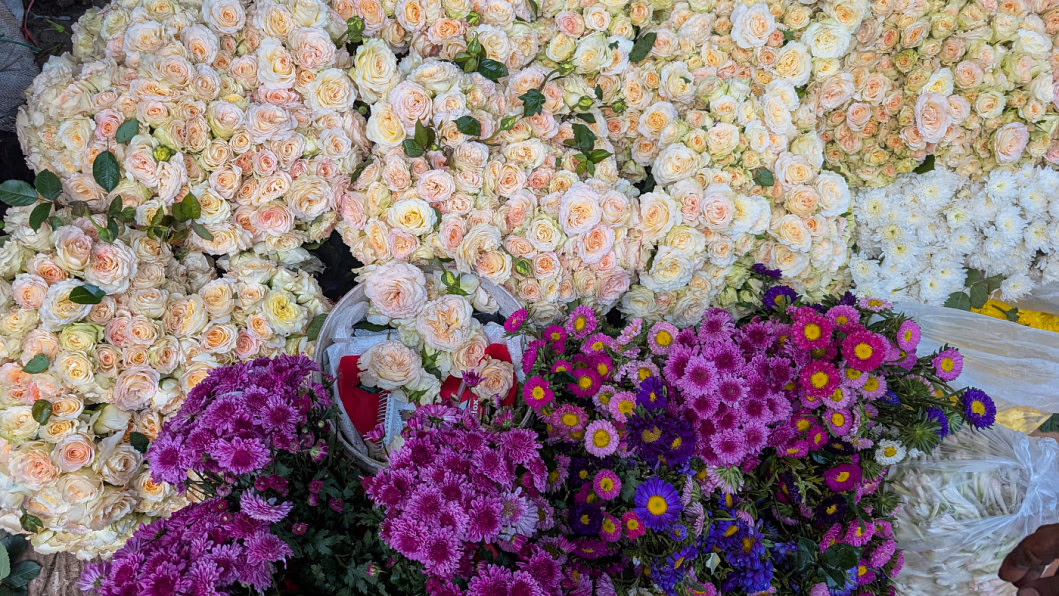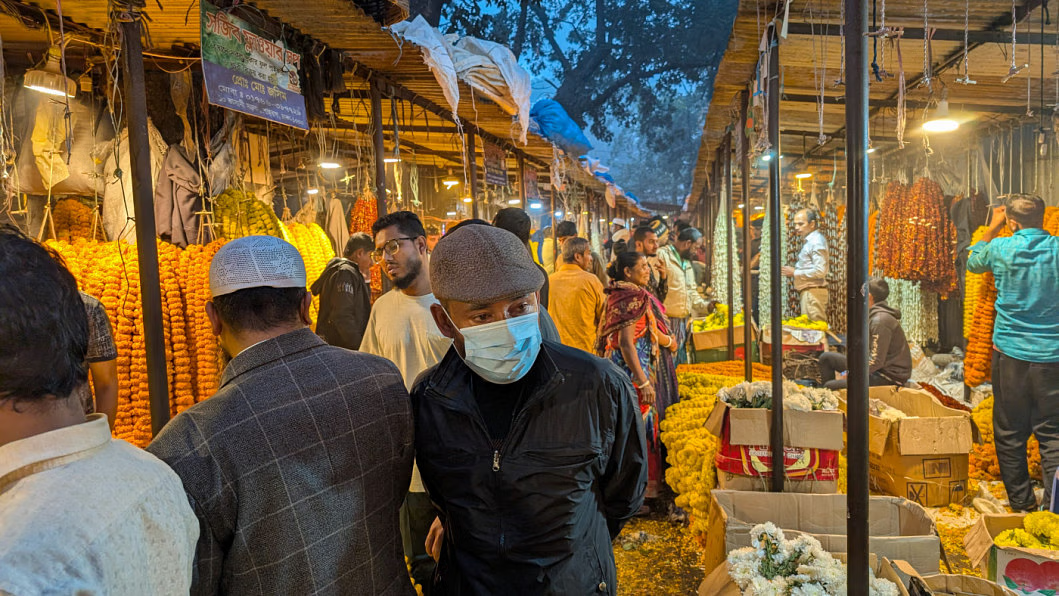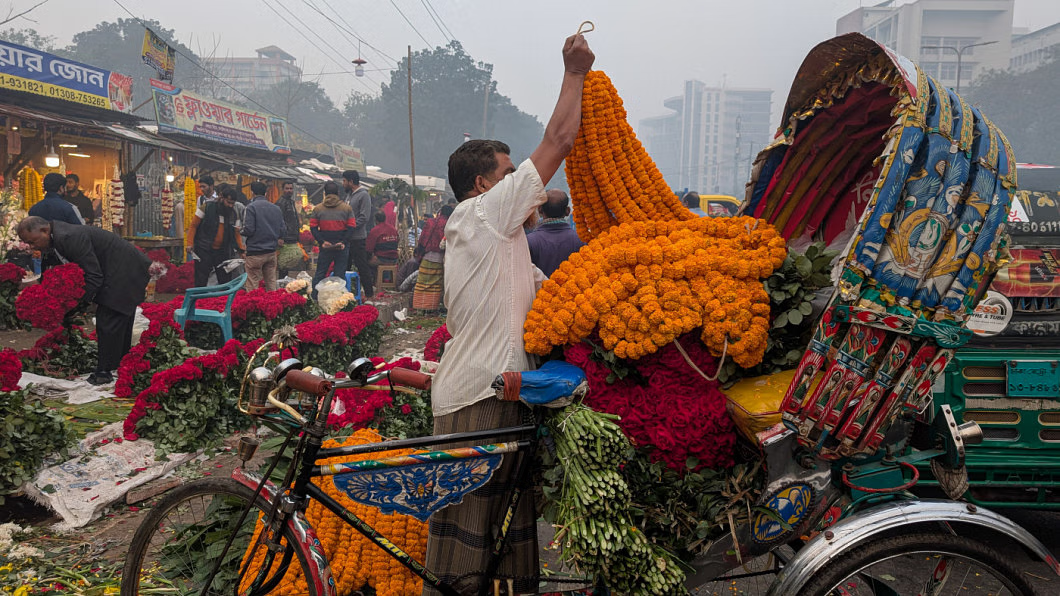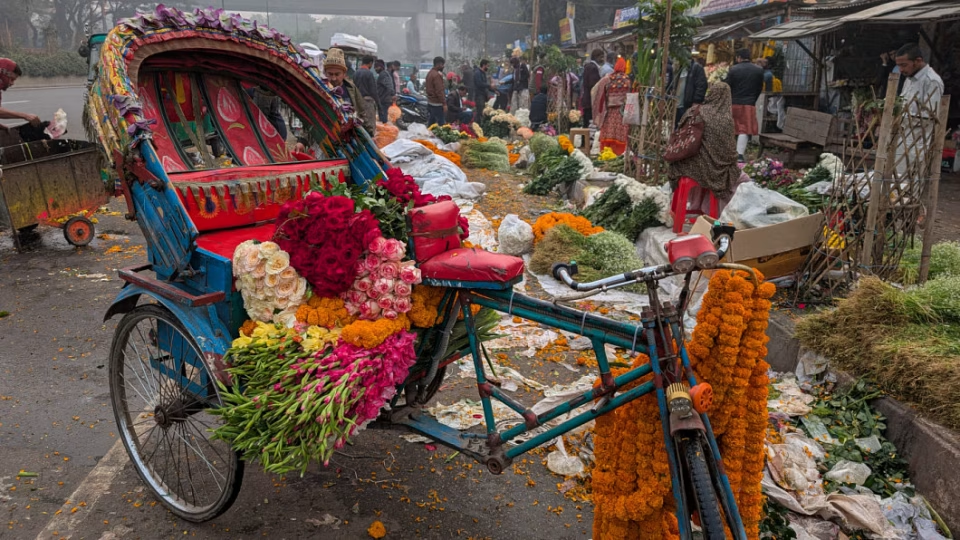February 14, 2025
DHAKA – With Valentine’s Day, Pahela Falgun, and Ekushey February in the same month, Dhaka’s flower markets come alive. Even before dawn, the air is filled with the scent of fresh blooms and a sense of excitement. From the shops at Shahbagh to the bustling stalls of Agargaon, these hubs of the city’s floral trade offer everything from classic roses to exotic chrysanthemums. By 3 AM, the once-quiet spaces transform into vibrant scenes of activity. Whether for arrangements, celebrations, rituals, or simply to brighten someone’s day, these early morning markets ensure that Dhaka awakens in a burst of rich, vivid colours.

The flowers that rule the market
“Roses, gladiolus, gerbera, chrysanthemum, calendula, tuberose, marigold, China rose and gypsy flowers are the most common. Marigolds and tuberoses are the most sold items all year round, but when it’s Valentine’s Day or Falgun — the days we wait for all year — nothing tops roses. Those days are the best days for our business,” adds Sujon.
When business starts between 2 and 3 AM, the area gets crowded and chaotic. The farmers and vendors arrive, unloading fresh flowers, while shopkeepers slowly set up their stalls. Once everything’s in place, sales go on all day.
At the Shahbagh flower market, the streets turn into a red field as the temporary shops on the streets overflow with roses, looking like a red carpet welcoming the morning. As you step inside the market, the vibrant yellow marigolds instantly capture your attention. The sweet smell of tuberoses fills the air, mixing with the fresh scent of countless other flowers. You will find gerberas in vivid orange, red, pink, and white next to calendulas and chrysanthemums. Every corner looks like a garden in full bloom.

A shop in the market stands out with its unique little flowers — button poms — wrapped in paper. Md Parvez Akbar from Mayer Doa Pushpalay explains, “Button poms are not always in high demand, but when it comes to elegant decorations, they’re pretty demandable. High-starred hotels often request them.”
The shop displays button poms in different colours including green, along with a variety of chrysanthemums, or as the locals call it “mums”, making it a vibrant spot in the market. “These flowers were originally imported, but now we grow them right here in the country,” Akbar shares.

From fields to markets
“The flowers are mostly sourced from Godkhali in Jashore and Birulia in Savar,” replies Moyna Begum, a temporary rose shop owner. Other sellers also mention that flowers are sourced from places like Jhenidah, Chuadanga, and Narayanganj.
Md Mamunur Rashid, who has been running Mamun Phul Ghar for nearly 22 years, explains, “There are two types of marigolds — the yellow one, called bashanti ganda, and the orange one, which we call lal ganda. The orange ones sell for Tk 150 per string, while the yellow ones cost between Tk 250 and Tk 350.”
Roses can be priced anywhere from as low as Tk 50 for 100 pieces to as high as Tk 3000, depending on the occasion and demand.
Imrul from Mayer Doa Flower Shop shares, “Generally, I sell roses at Tk 200 for 100 pieces. However, during special occasions like International Mother Language Day, Rose Day, or Valentine’s Day, the price can rise to as much as Tk 2000 per 100 pieces.”
Samirul Islam, a farmer and seller, has been growing roses in his fields in Birulia, Savar, for 14 years. He explains, “Wholesale market sellers buy flowers directly from farmers. If they can purchase them at a lower price, they can sell them at more affordable rates.
“The farmers sell their flowers and they’re done for the day. But sometimes, like myself, the farmer can also be the seller. I pick the flowers myself, bring them with a pick-up truck, and sell them directly at this temporary shop here at Shahbagh.”
About the pricing, Islam shares an interesting insight into flower production: “Garden flower production rises when there’s plenty of sunlight. But when there’s fog, production drops significantly, and the prices go up.”

Voices from the Agargaon market
Another major wholesale flower market in Dhaka is located in Agargaon. The market originally began at Khamarbari but was later moved to Agargaon. It begins as early as 3 AM and finishes by 9 or 10 AM.
Md Wazed Ali, who has been in the flower business for nearly 20 years, shares, “I started my business in Sadullapur, Birulia, then moved to Khamarbari. Later, the wholesale market moved from Khamarbari to Agargaon, probably 10-12 years back.”
He continues, “I mainly sell roses, offering 50 pieces for just Tk 50. On different occasions, the roses are sold at higher prices.”
A beautiful, though temporary, shop in front of the Agargaon flower market is sure to grab anyone’s attention.
Taslima, a 60-year-old woman, has decorated her shop with great care. Her stall is filled with vibrant Easter lilies, mum flowers, and button poms. It’s a family business — her son sells white roses on the other side of the market. He handles the buying, while Taslima manages the shop.
“My shop was originally in Shahbagh, but I moved here,” she shares.
Shopkeepers look forward to special days like Valentine’s Day or Falgun, as sales on these occasions are significantly higher compared to regular days. However, Taslima shares that sales might be lower this year.
Sohan, a gerbera seller, explains, “Due to the current situation in the country, sales are usually not very good on normal days. Even though we don’t expect sales to be as high as before, we can still hope for a good turnout.”
Despite the challenges, flower sellers stay hopeful, managing the ups and downs with determination. From the hands of the farmers who grow the flowers, to the journey through the market, and finally reaching the hands of your favourite person, these markets reflect the hard work and passion of those who bring beauty to the city. Let’s just hope the city continues to appreciate them in return.


